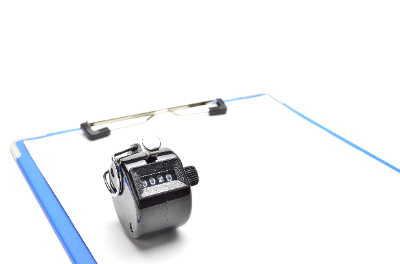What Is a Counter?

A counter is a device, tool or part that counts.
When counting, a small number can be easily counted and memorized, but when the number is large, it becomes difficult to do so by memory alone. Therefore, a counter is a device that counts numbers correctly on behalf of a human being.
Uses of Counters
Counters are used to help people remember numbers, and are called counters. Counters are used to count the number of cars passing by in traffic surveys, for example. Currently, it is possible to replace counters with smartphone applications.
There are also counters that are incorporated into industrial equipment as electrical components. They are called digital counters and are mainly used inside control panels at production sites.
Types of Counters
Digital counters include preset counters and total counters.
1. Preset Counter
A control signal is output when the count reaches a preset value.
Common input signals are pulse signals and contact open/close signals. Digital signals such as contact outputs or transistor outputs are used as output signals.
When it is desired to stop the output of the counter, a reset process is performed. Reset processing can be done with a pushbutton or by short-circuiting the reset terminal.
Many preset counters require an auxiliary power supply to supply electricity to the counter itself. Auxiliary power supplies can be purchased in AC or DC power supplies of your choice.
2. Total Counter
This counter has only the function of displaying the count value. It counts contact and pulse inputs and displays the count value on an output screen.
The total counter can also be reset to zero. Reset processing is performed with the pushbutton or reset terminal as with the preset counters.
Many total counters are also available with a built-in battery, eliminating the need for an auxiliary power supply. In addition to the above, there are also time counters that measure the duration of contact output.
There are also addition counters that increase the count value for each signal input and subtraction counters that decrease the count value in the opposite direction. Since there are many types of counters and their specifications vary, it is necessary to select the right counter for the right application.
Counter Principle
In the case of a counter, a human-powered pushbutton turns a character wheel to produce an output. The internal circuit only uses gears to drive the character wheel, and the reset button also manually returns the character wheel to 0.
Digital counters are mainly divided into three parts: the display section for displaying the count value, the internal circuit for receiving input signals and performing operations, and the operation section for resetting or presetting the value.
Input signals are sent to the counter in a variety of ways, including input by pushbuttons and digital input using sensors. Digital counters are generally input by contact. A pushbutton with a contact can be used to convert the input to a pushbutton input.
The internal circuitry always holds the current value. The initial value is generally 0, but it can be set arbitrarily. Upon receiving an input signal, the counter’s internal circuitry displays the current value plus one on the display.
When a preset counter is used, the output signal can be sent out by performing a preset. The preset value is compared with the current value, and if it is equal to the set value, an output signal is output.
When the operation is completed, the counter enters a state waiting for an input signal and prepares for the next operation. By repeating these series of operations, the counter counts the number of digits and continues to display the number of digits on the display.
The display section can be character wheel or digital. Most of the counters that use a character wheel are called electromagnetic counters, and they make use of an electromagnet to turn the character wheel. Electromagnetic counters have the advantage of maintaining the display even without a power source.
In recent years, counters with digital displays are also widely used. Digital displays require a power supply, but light-emitting ones have the advantage of being easy to see in the dark.